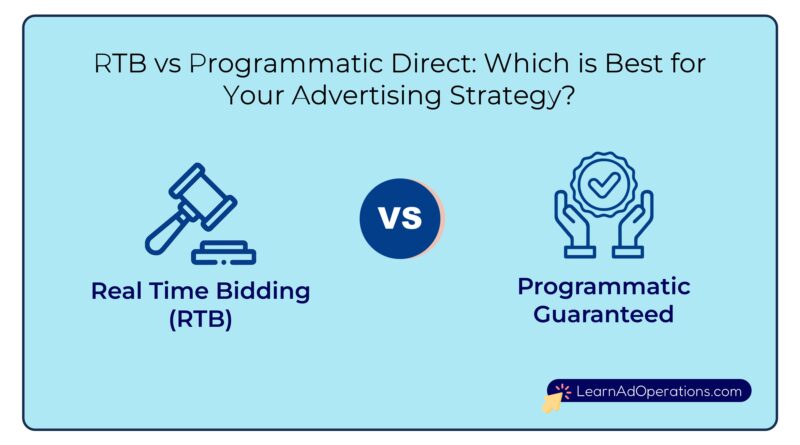Real-Time Bidding (RTB) vs. Programmatic Direct: Pros and Cons
Programmatic advertising has emerged as a game changer in digital advertising by incorporating RTB and Programmatic Direct modules. These new offerings have unparalleled opportunities for advertisers to target their desired audience effectively.
Increasing Ad Spend of advertising campaigns, the advertisers need to understand the nuances of various programmatic advertising methods to optimize their ad campaigns. There are two key methods are Real Time Bidding (RTB) and Programmatic Direct in the Programmatic advertising landscape.
This article shed some light on understanding the difference between Real Time Bidding (RTB) and Programmatic Direct and their advantages and disadvantages to take informed decisions while choosing these methods.
Understand Real Time Bidding (RTB)
What is Real Time Bidding (RTB)?
Real Time Bidding is a technology that programmatic advertising uses to buy and sell the ad impressions in real time through auction model. The entire process takes place within milliseconds as soon as the ad requests triggers from the ad slots.
Advertisers, publishers, ad exchanges, demand side platform (DSP), and supply side platforms (SSP) are the key players in RTB ecosystem. The key players are connected through ad exchanges to buy and sell the ad inventories in real time.

Advantages of Real Time Bidding (RTB)
- Flexibility: One of the key benefits of real time bidding is flexibility. Advertisers can adjust their bids in real time to optimally utilize their ad budget to improve the overall campaign performance.
- Cost Efficiency: Advertisers have control over bidding on each impression that meets their targeting criteria. It will ensure to spend the ad budget on the impressions that are meeting the campaign targeting.
- Targeting Capabilities: Advertisers are enabled to target audience using demographics, geographic, and behavioral targeting options. The précised targeting will help the advertisers to reach the targeted audience with right ad at the right time.
- Scalability: Advertisers have access to wide range of ad inventories that matches their budget and requirements from multiple publishers. It will allow advertisers to choose the ad inventory help achieving the campaign goal.
Disadvantages of Real Time Bidding
- Ad Fraud Risks: The real time nature of RTB can expose advertisers to the risk of ad frauds which includes generating impressions and clicks from bots leads to losing the ad budget.
- Brand Safety Concerns: RTB can allow all the advertisers to participate in the auction leads to ads may appear on unwanted websites which potentially damage the brand name.
- Lack of Transparency: One of the major challenges is to track where the ads are serving on the publisher’s website. This concern leads to transparency and accountability issues with online advertising.
- Complexity: RTB campaign setup looks to be simple and straight forward. However, managing the campaign performance needs technical knowledge and specialized tools.
Understanding Programmatic Direct
What is Programmatic Direct?
Programmatic Direct is a type of Programmatic Advertising that allows advertisers to purchase the desired inventory directly from publishers without going through the auction. The method includes many deal types like Private Marketplace (PMP), Programmatic Guaranteed Deals and Preferred Deals,
Advertisers can negotiate the pricing and ad placements before setting up the campaign. Programmatic Direct improves the transparency of ad serving and advertisers can easily track the performance.

Advantages of Programmatic Direct
- Transparency: Programmatic Direct enables advertisers know exactly where their ads serving on the publisher’s website. It helps the advertisers building trust on publishers and ensuring accountability of ad serving.
- Brand Safety: Advertisers have better control over where their ads placed on publisher’s websites. It ensures advertisers have greater control over their brand safety on serving the ads on the agreed ad slots.
- Guaranteed Impressions: Programmatic Direct provides advertisers with guaranteed ad impressions, ensuring that their ads reach the desired audience.
- Better Relationships: Programmatic Direct fosters closer partnerships between advertisers and publishers. It will create better collaboration and tailored advertising solutions.
Disadvantages of Programmatic Direct
- Higher Cost: Programmatic Direct deals are generally more expensive than open auction. Programmatic Direct deals offer premium inventory and assured ad placements to the advertisers leads higher cost.
- Limited Flexibility: Unlike RTB, Programmatic Direct offers limited flexibility in optimizing the campaigns real time.
- Inventory Limitations: Advertisers usually get the limited impressions in Programmatic Direct compared to RTB. The publishers not allow advertisers book their entire inventory which leads other campaigns under delivering.
- Time Consuming: Programmatic Direct campaigns are time consuming as it requires negotiation and time to finalize the terms with publishers.
Comparing RTB and Programmatic Direct
Use Cases for RTB
- Ideal for Performance Marketing: RTB is the best suited for advertisers who are focused on performance metrics such as click through rate and conversions.
- Wide Reach: It is ideal for campaigns targeting a broad audience across multiple websites and platforms.
- Dynamic Campaigns: RTB is perfect for advertisers who needs to adjust their campaigns frequently based on real time data.
Use Cases for Programmatic Direct:
- Brand Awareness Campaigns: Programmatic Direct campaigns are ideal for advertisers who are looking to build brand awareness on premium websites with guaranteed placements.
- High Value Products: Programmatic Direct is suitable for campaigns promoting high value products or services where brand safety and transparency are paramount.
- Long Term Partnership: Advertisers looking to establish a long-term relationship with specific publishers can be benefit from Programmatic Direct deals.
Key Differences between RTB and Programmatic Direct
- Cost: RTB is generally more cost-effective, while Programmatic Direct involves higher costs due to premium inventory.
- Flexibility and Control: RTB offers more flexibility, while Programmatic Direct provides greater control over ad placements.
- Transparency and Safety: Programmatic Direct excels in transparency and brand safety, while RTB requires additional measures to ensure these aspects.
- Audience Targeting Capabilities: RTB offers more advanced targeting options, while programmatic direct focuses on pre-negotiated deals.
Making Right Choice for Your Business:
Factors to Consider
- Business Objectives: Define your advertising goals and determine which method aligns best with your objectives.
- Budget and Resources: Assess your budget and resources to decide if RTB’s cost-efficiency or Programmatic Direct’s premium costs are a better fit.
- Brand Safety and Transparency Needs: Consider the level of brand safety and transparency required for your campaigns.
- Desired Level of Control and Flexibility: Determine whether you need the flexibility of RTB or the control of Programmatic Direct.
Related Articles on Programmatic Advertising:
- Effective Targeting Strategies for Programmatic Advertising
- The Role of DSPs and DMPs in Programmatic Advertising
- The Role of Ad Exchanges and SSPs in Programmatic Advertising
- The Evolution of Programmatic Advertising: From RTB to AI
Recommendations
Integrating Both Strategies: For a comprehensive approach, consider integrating both RTB and Programmatic Direct in your digital marketing strategy to leverage the strengths of each method.
Conclusion
Understanding the differences between Real Time Bidding and Programmatic Direct is crucial for optimizing your digital marketing strategy. By evaluating the pros and cons of each method, you can make informed decisions that align with your business goals and ensure maximum return on investment (ROI). Whether you choose RTB for its flexibility and scalability or Programmatic Direct for its transparency and control, the key is to adapt and evolve with the ever-changing digital advertising landscape.




